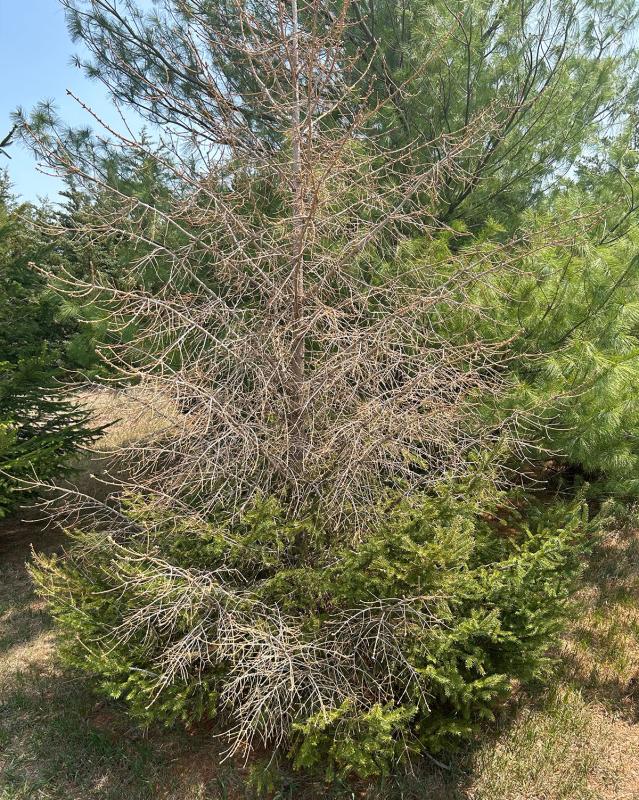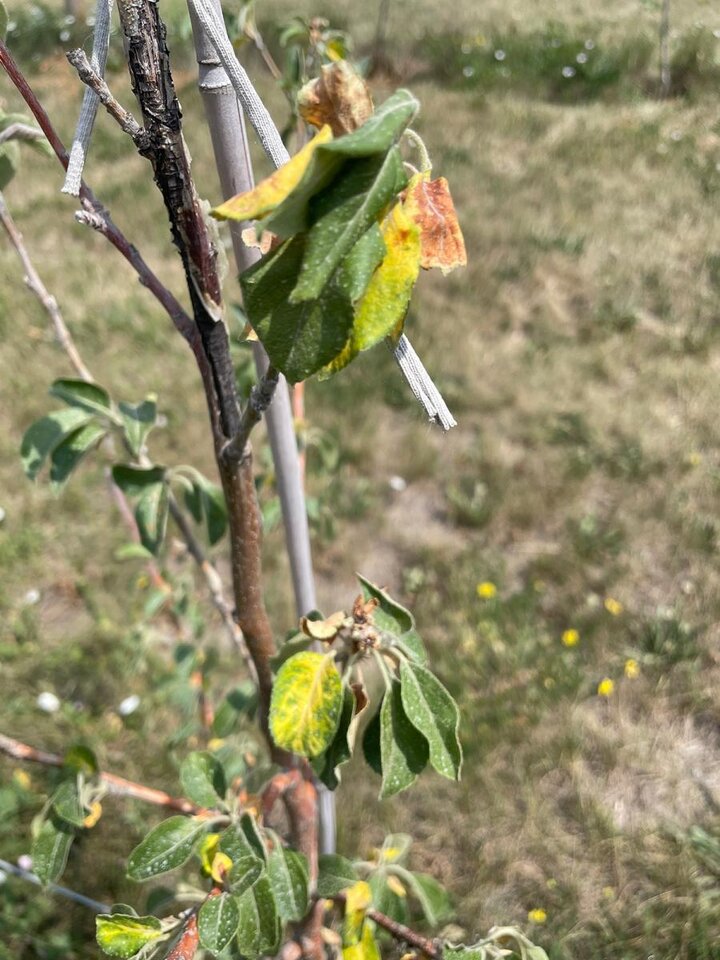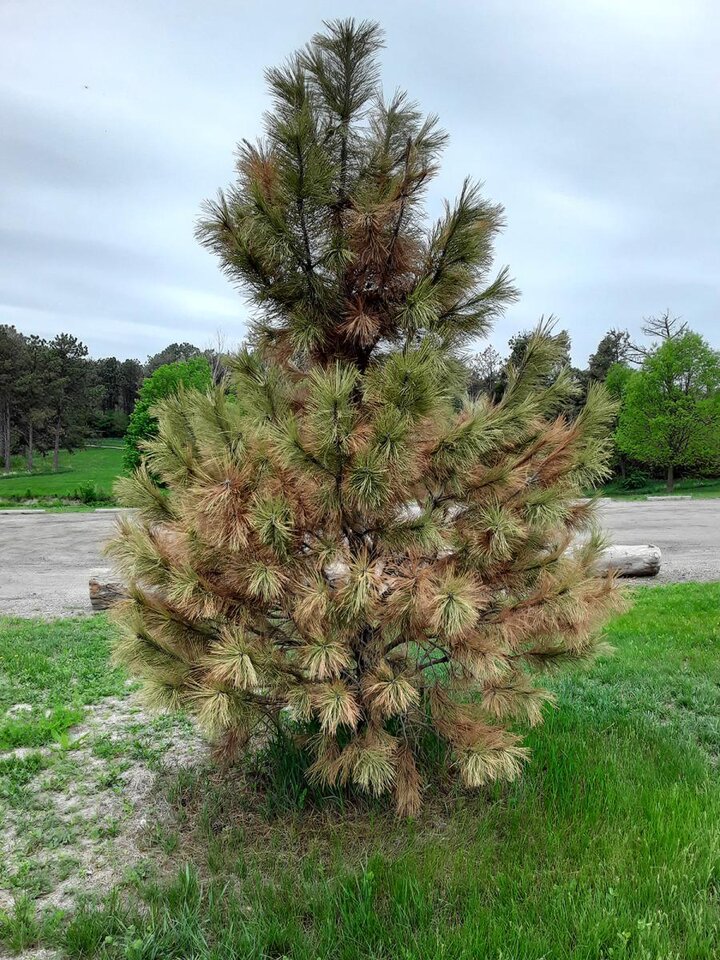Sarah Browning, Nebraska Extension Educator

Severe drought damage on spruce. Client image used with permission
Just as drought has caused havoc in many lawns, we’re also seeing damage in trees. Even very drought tolerant trees like eastern red cedar and Colorado spruce have extensive damage or have been killed completely.
Death of branches or a whole tree are very obvious and visible effects, but drought can also cause damage in more subtle ways affecting trees and other woody plants for several years to come.
In a well-hydrated soil, the open spaces between soil particles – called soil pores- are filled with 50% oxygen and 50% water. When dry, clay and loam soil may still contain some water, making the soil feel cool and somewhat moist, but this water is held so tightly by soil particles that it cannot be pulled up by plants. This remaining water is not available to plants.

How Does Drought Cause Damage in Woody Plants?;
Plant-available water is pulled up by very fine root hairs. They are aided in this process by mycorrhizal fungi - beneficial types of fungi which produce extensive networks of fungal roots. Mycorrhizal fungi extract nutrients and water from the soil, then pass it to tree roots in exchange for carbohydrates (sugars) manufactured by the plant through photosynthesis. Mycorrhizal roots grow faster than plant roots, at a lower “expense” in terms of required energy, carbohydrates and nutrients. Researchers estimate mycorrhizal fungi can expand a tree’s root system by five times or more!
As soil dries, the amount of available water decreases to a point where mycorrhizal fungi and plant roots can no longer pull up water. If dry conditions last too long, mycorrhizal roots and plant root hairs begin to dry out and die. Next, progressively larger roots die and the cycle continues until soil water is replenished.
Worsening mycorrhizae and root death reduces the tree’s overall root system, shrinking the area from which the tree can pull up water. And, once tree root hairs die, it can take several days or weeks for them to regrow – one reason woody plants are slow to recover.

Why Is One Tree Damaged, But It’s Neighbors Are Fine?;
It’s very common for some trees to be more easily damaged by drought. This is most visible in windbreaks where multiple trees of the same species are planted together. Usually this is caused by a condition(s) which restricts growth of the affected tree’s root system, often going back to the day it was planted.
Common causes for increased stress susceptibility include the following.
- Planting depth (too deep)
- Girdling roots
- Rope, strapping or wire left around the tree’s trunk at planting
- Compacted or disturbed soil
- Overly wet soil due to improper turf irrigation, poor soil drainage or a high water table
Affected trees start at a disadvantage when experiencing due to 1) their smaller/restricted root system and/or 2) their reduced ability to move water through the trunk. These factors make them more easily stressed and damaged by drought.

Symptoms of Drought Stress
Short term drought symptoms are often seen in a plant’s leaves, including wilting, yellowing, and scorch. This is true for landscape ornamentals, shrubs and trees. Woody plants suffering ongoing drought often drop leaves early to minimize their water need, which results in early defoliation.
Symptoms of long-term drought include 1) a sparse or thin canopy of leaves, 2) small leaves not fully expanded, 3) slow growth, 4) twig & branch death and 5) increased susceptibility to pests like borers or fungal canker infections for several years after the drought ends.
This spring, several common types of drought damage can be found in home landscapes.
- Ornamental cherries & plums – tree death.
- River birch - extensive dead branches at the top of the canopy.
- Spruce - purpling of needles, extensive dead branches throughout a tree, death of the tree’s top section or complete tree death.
- White pine - severe needle scorching, where the outer one-half (or more) of needles turn brown due to extensive water loss. In some situations, death of the entire tree has occurred.
Recovery
What can be done to prevent additional stress and damage? If damage isn’t too extensive, plants may still be saved. Start by pruning out any dead branches and making sure all the trees are mulched - but don’t fertilize!
Finally, check out the following publications for more specifics on how to mulch and water to prevent or alleviate drought.
- Summer Watering for Trees, Nebraska Extension
- Tree Watering Tips for Drought Conditions, South Dakota State University Extension
- Watering Established Trees and Shrubs, University of Minnesota Extension
Images
- Crabapple wilting due to drought. Client image used with permission.
- Severe drought damage on pine. Client image used with permission.
- Canopy dieback in birch due to drought. Image by Sarah Browning, Nebraska Extension.
Search Our Archive
Associated Video
Watering Drought Stressed Trees and Shrubs
UNL East Campus Landscape Services Manager Jeff Culbertson demonstrates watering techniques to helping trees and shrubs survive drought.